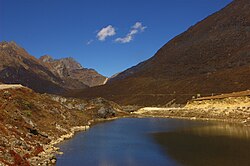Conflicts between China and India
Main article: Sino-Indian War
The NEFA (North East Frontier Agency) was created in 1954. The issue was quiet during the next decade or so of cordial Sino-Indian relations, but erupted again during the Sino-Indian War of 1962. The cause of the escalation into war is still disputed by both Chinese and Indian sources. During the war in 1962, the PRC captured most area of Arunachal Pradesh. However, China soon declared victory, voluntarily withdrew back to the McMahon Line and returned Indian prisoners of war in 1963. The war has resulted in the termination of barter trade with Tibet, although in 2007 the state government has shown signs to resume barter trade with Tibet.[15][edit] After the war
Arunachal Pradesh became a separate state of India in 1986.Of late, Arunachal Pradesh has come to face threats from certain insurgent groups, notably the National Socialist Council of Nagaland (NSCN), who are believed to have base camps in the districts of Changlang and Tirap.[16] There are occasional reports of these groups harassing local people and extracting protection money.[17]
[edit] Geography

Arunachal Pradesh is famous for itsmountainous landscape.

The Himalayas bordering Arunachal Pradesh
At the lowest elevations, essentially at Arunachal Pradesh's border with Assam, are Brahmaputra Valley semi-evergreen forests. Much of the state, including the Himalayan foothills and the Patkai hills, are home to Eastern Himalayan broadleaf forests. Toward the northern border with China, with increasing elevation, come a mixture of Eastern and Northeastern Himalayan subalpine conifer forests followed by Eastern Himalayan alpine shrub and meadows and ultimately rock and ice on the highest peaks.
In 2006 Bumla pass in Tawang was opened to traders for the first time in 44 years. Traders from both sides of the pass were permitted to enter each other's territories, in addition to postal workers from each country.
The Himalayan ranges that extend up to the eastern Arunachal separate it from Tibet. The ranges extend toward Nagaland, and form a boundary between India and Burma in Changlang and Tirap district, acting as a natural barrier called Patkai Bum Hills. They are low mountains compared to the Greater Himalayas.[18]
[edit] Climate
The climate of Arunachal Pradesh varies with elevation. Areas that are at a very high elevation in the Upper Himalayas close to the Tibetan border enjoy an alpine or Tundra climate. Below the Upper Himalayas are the Middle Himalayas, where people experience a temperate climate. Areas at the sub-Himalayan and sea-level elevation generally experience humid, sub-tropical climate with hot summers and mild winters.Arunachal Pradesh receives heavy rainfall of 80 to 160 inches (2,000 to 4,100 mm) annually, most of it between May and September. The mountain slopes and hills are covered with alpine, temperate, and subtropical forests of dwarf rhododendron, oak, pine, maple, fir, and juniper; sal (Shorea) and teak are the main economically valuable species.
[edit] Sub-divisions
Arunachal Pradesh is divided into sixteen districts, each administered by a district collector, who sees to the needs of the local people. Especially along the Tibetan border, the Indian army has a considerable presence due to concerns about Chinese intentions in the region. Special permits called Inner Line Permits(ILP) are required to enter Arunachal Pradesh through any of its checkgates on the border with Assam.Districts of Arunachal Pradesh:

No comments:
Post a Comment